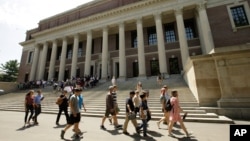International students are returning to the United States after a significant drop during the pandemic, according to the Open Doors 2022 Report on International Educational Exchange (IEE).
During a conversation late last week with reporters about the report, issued Monday, higher education officials said enrollment of international students increased almost 4% in the 2021-2022 academic year from the year before, and almost 9% in the fall of 2022, from the year before. International student enrollment dropped 15% in the 2020-2021 school year.
Almost 1 million students came to the U.S. in the 2021-2022 academic year from more than 200 countries. Most of the increase is attributed to graduate students who had deferred their enrollment until they were able to come to the U.S. to study in person.
"Last year [2020-2021], you may remember that due to COVID-19, new enrollments dropped by 46 percent," according to Mirka Martel, who is the director of research for the Institute of International Education, known as IIE. "Many international students at that time decided to defer their enrollment or pause their academic plans. This year [2021-2022], we saw that new enrollments soared 80 percent year over year to over 261,000 students. This brings new international student totals back to pre-pandemic levels, and it is notable that new enrollments increased across all academic levels."
The Open Doors report, a collaboration between the IIE and the U.S. State Department’s Bureau of Educational and Cultural Affairs, features 3,000 colleges and universities in all 50 states.
“We have over 100 years of data on international student mobility to the United States. This data includes 12 pandemics and shows that educational exchanges occur even during them and grow rapidly afterwards,” said Allan Goodman, IIE’s CEO, adding that the rebound matches historical precedents.
Chinese students
China has long sent the most students to the U.S., according to the report. And while China remains the top place of origin of all international students, enrollment did drop in the 2021-2022 academic year.
"The total number of Chinese students declined by 9 percent from the previous [academic] year. The most significant decreases among Chinese students were at the undergraduate and [Optional Practical Training] levels at 13 percent and 22 percent, respectively," Martel told reporters. "At the same time, we know that the total number of Chinese graduate students increased by 4 percent."
Optional Practical Training allows international students to temporarily work in a field related to their academic focus.
When asked what the government is doing to streamline the immigration process for international students from China, Rob Batchelder, managing director for visa services in the Bureau of Consular Affairs at the State Department, said there are no backlogs or visa wait times for students coming to the U.S. for science, technology, engineering and mathematics (STEM) fields, those favored most by Chinese students.
"In terms of scrutiny, the difficulty really is no harder or more complicated than anywhere else in the world [for a visa application]. ... The vast overwhelming majority of Chinese students who are looking to study in the U.S., including in STEM fields, are able to get their visa and travel to the United States to study here without any serious delays or complications," Batchelder said.
The latest State Department data from its consulates in China show an average two- to three-day wait for international student visa interviews.
In the 2021-2022 school year, about 291,000 Chinese students were studying in the U.S., the lowest number since the 2013-2014 academic year. The highest enrollment number for Chinese students was 372,532 in 2019-2020.
Worldwide, the average wait time for international student visa interviews is seven days, according to Julie Stufft, deputy assistant secretary for visa services with the State Department’s Bureau of Consular Affairs.
In July 2022, student visa interviews were backlogged 49 days — five times the wait pre‐pandemic, said David Bier, associate director of immigration policy at the libertarian Cato Institute.
During a briefing with reporters Thursday, Stufft said the State Department has issued more student visas in 2022 than any year since 2016.
"Our embassy and consulates in India broke their all-time record for the number of student visas issued in a single year — about 125,000. Students are, like so many other sectors, very important," she said.
International students contributed $32 billion to the U.S. economy in 2021, according to data from the U.S. Commerce Department.
More trends in 2021-22
South Korea saw an increase in students coming to the United States after decades of decline. But enrollment by students from Saudi Arabia saw its sixth consecutive year of decline.
The second-highest total number of students in the 2021-2022 year, behind China, was India with 199,182 students. That country’s numbers have practically doubled over the past decade.
"And certainly, some of the data we're seeing from certain places of origin, particularly Nigeria and others, is incredibly promising," said Martel of IEE.
The number of Nigerian students in the United States increased 12% from the previous year, to 14,438 students.
That number "goes back to highs that we saw in the mid-'80s," Martel said. "So, certainly there is a positive picture here. And speaks to a great opportunity in terms of an emerging market and a market for international students looking to pursue study in the United States."













